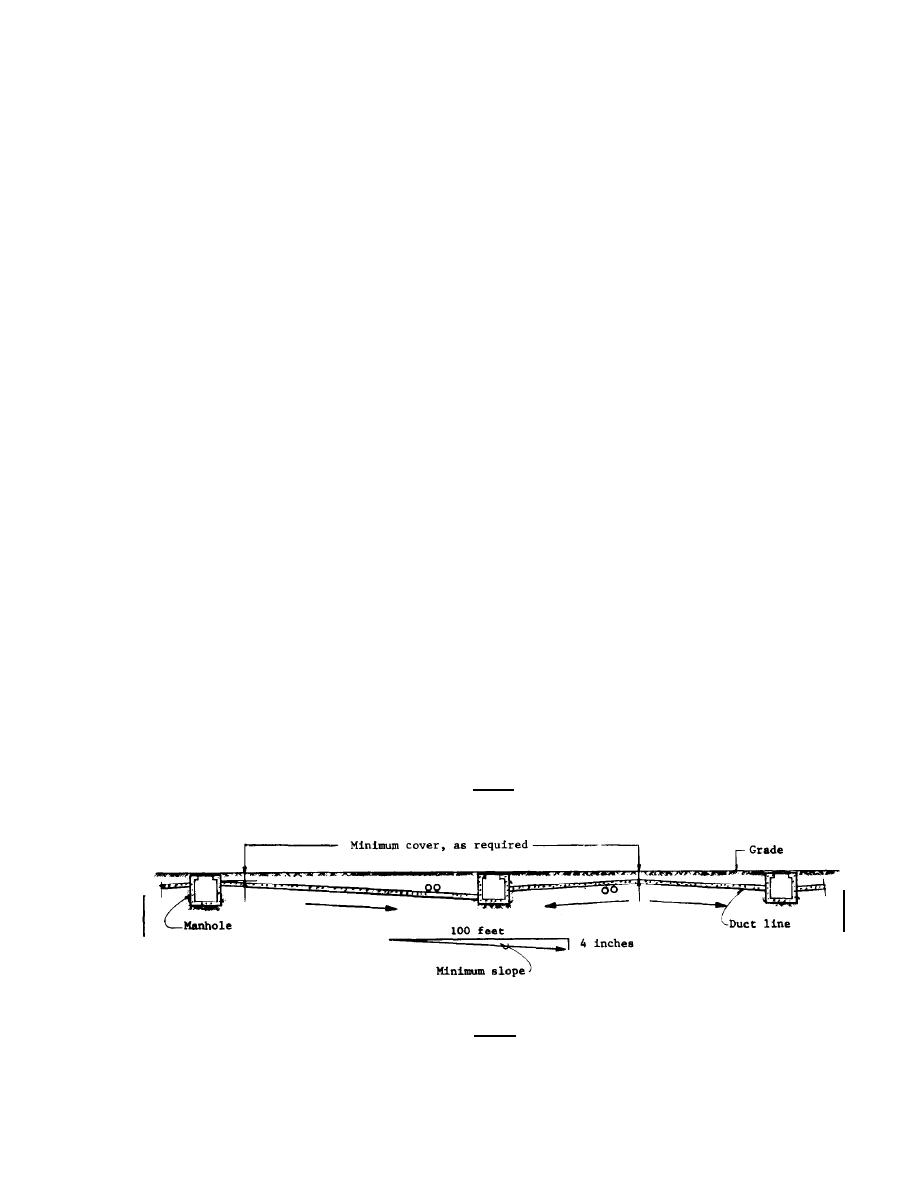
TM
5-811-1/AFJMAN
32-1080
by the Using Agency, and then equipment will be
from manhole and ductline systems or other
of the type which can be submersed. Where the
sources for low-voltage power and communication
water table is high enough to flood manholes,
supply to building services. A handhole suitable
water will be removed by portable pumps operated
for most electric power or communication usage is
on a regular schedule. Permanently connected
shown on figure 7-8. At least four racks will be
sump pumps will not be installed, except in special
installed. Where more than two splices occur, a
instances. Permanent ladders will not be installed;
manhole may be more appropriate.
(2) Pullboxes. Pullboxes are used for electric
portable ladders will be used when required.
(4) Manhole appurtenances. Ground rods will
circuits supplying low-voltage electric loads which
be installed in one corner of each electric manhole
require conductors no larger than No. 1/0 AWG
for metallic shield or sheath grounding to reduce
and no more than one 2-inch conduit entrance at
induced potential gradients. Dangerous gradients
each side. Where larger conduits are installed,
are not induced by communication circuits, so rods
handholes or manholes will be used. Because
will not be installed in communication manholes.
pullbox depths are less than two feet, conduits
Other manhole appurtenances are shown on figure
must always slope up into the pullbox. Pullboxes
7-7. Square covers will not be used because of the
are also suitable for fire alarm, public address, and
danger of the cover slipping through the opening.
control circuits. Pullboxes will not be used for
The traffic cover shown on figure 7-7 is suitable
telephone circuits without the approval of the
for AASHTO H20 wheel loadings. Pulling-in irons
appropriate communication agency. Figure 7-9
will be provided opposite each duct entrance or
shows standard sizes of pullboxes used for low-
where there are provisions for future duct en-
voltage installations. Pullboxes will not be used in
trances. Sufficient cable racks will be installed to
areas subject to vehicular traffic. In such areas,
properly support cables on both sides of any cable
handholes will be installed. The use of a pullbox at
splice and elsewhere as needed. Rack horizontal
the base of a lighting pole is unnecessary in most
spacing will be 3 feet to 4- feet for electric
cases.
power cables dependent upon the nature of the
c. Manholes at Air Force installations.
cable bends. At least two racks will be located on
(1) General requirements. Manholes shall be
each wall, except, racks will not be more than 30
adequately sized, shall comply with applicable
inches apart horizontally.
requirements of OSHA, and AASHTO, and may be
(5) Communication manholes are to be de-
precast or cast-in-place. Openings should be round
signed in accordance with Army Field Manual
and not less than 32 inches in diameter.
11-486-5, Telecommunications Engineering Out-
(2) Manholes for aircraft operating and park-
side Plant Telephones, paragraphs 7-17 to 7-30.
ing aprons. Electrical manholes in aprons shall be
b. Other Types of Cable Access Points. Where
avoided. Cables shall be installed beyond the
splicing or pulling of cables requires an access
periphery of aprons. Electrical manholes shall
point, but the volume provided by a manhole is
maintain a distance of 50 feet from the edge of
unnecessary, handholes or pullboxes will be pro-
paving and 50 feet from any hydrant lateral
vided as appropriate.
control pit and 200 feet from a fueling point.
(1) Handholes. Handholes are used on laterals
DUCT LINE ELEVATION
US Army Corps of Engineers
Figure 7-3. Duct Line Drainage.
7-9



 Previous Page
Previous Page
